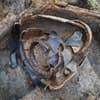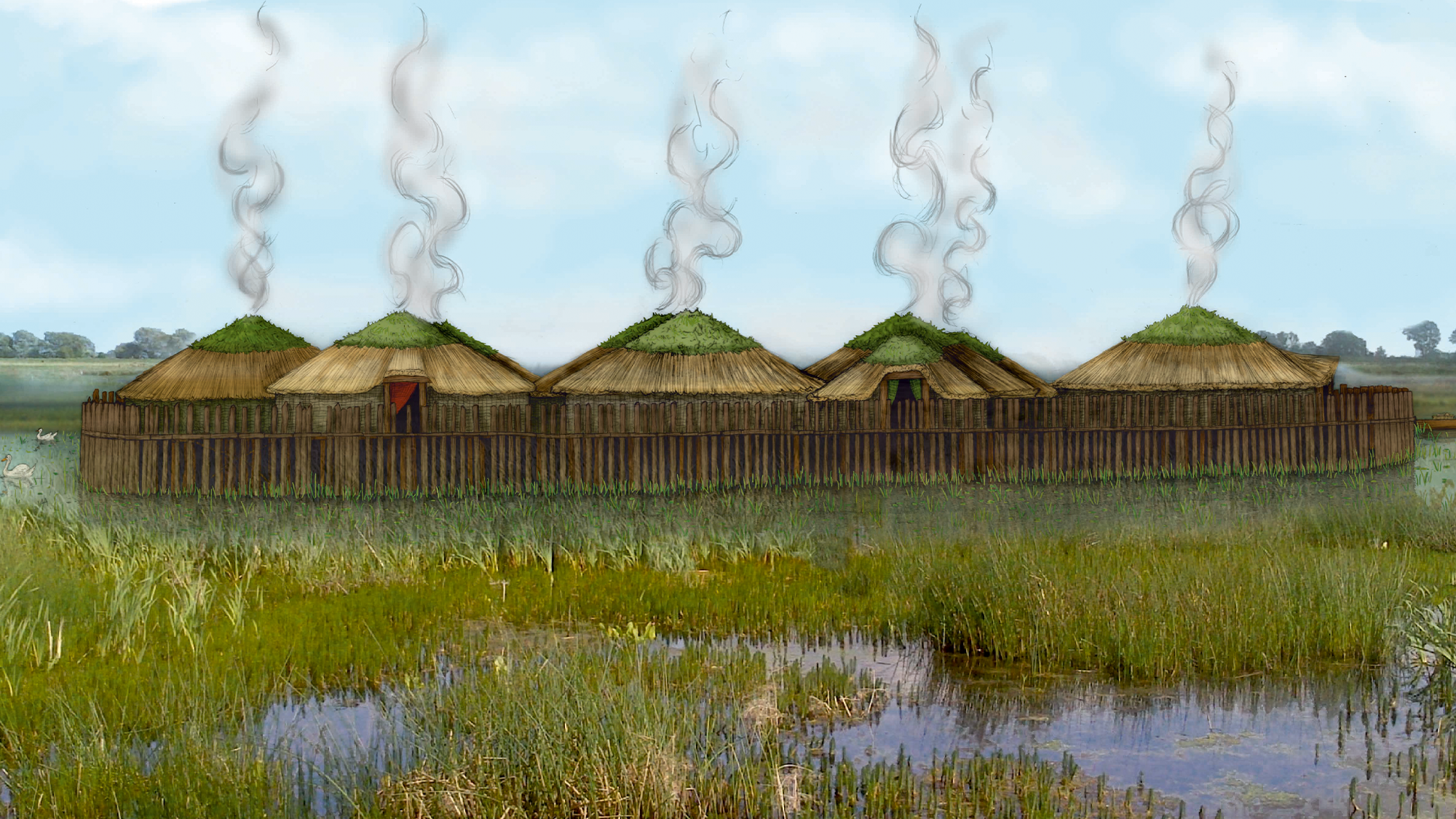[ad_1]
It was once a small and seemingly cozy late Bronze Age village. A settlement of five circular dwellings was built on stilts about 6.5 feet above a rambling river in eastern England. The homes were full of domestic knick knacks that paint a picture of daily life about 3,000 years ago. By all available evidence, Must Farm was a peaceful settlement constructed by skilled builders. That is, until a catastrophic fire engulfed “Britain’s Pompeii” and its buildings and materials plunged into a muddy river below.
Now, the first of two reports published March 19 by the University of Cambridge Archaeological Unit (CAU) delves into the details of the Must Farm settlement. This prehistoric stilted village dates back to about 850 BCE and was built in a swampy wetland locals call The Fens or Fenlands. The settlement was excavated in 2015 and 2016 after it was discovered on the edge of the town of Whittlesey, northwest of Cambridge.

According to the team, the site provides them with a unique blueprint for the circular architecture, home interiors, and overall domesticity of the prehistoric “fenlanders” who lived in England’s east.
“These people were confident and accomplished home-builders. They had a design that worked beautifully for an increasingly drowned landscape,” report co-author CAU archaeologist Mark Knight said in a statement. “While excavating the site there was a sense that its Bronze Age residents had only just left. You could almost see and smell their world, from the glint of metal tools hanging on wattled walls to the sharp milkiness of brewed porridge.”
An archeological mirror
The Must Farm dig site currently contains five total structures with walkways that connect them, surrounded by a fence about 6.5 feet high made from sharpened posts. However, the original settlement was likely twice as big. During the 20th Century, half the remains were removed when the area was quarried. The team believes that the site may have been home to at least 60 people living in family units.
[Related: Details of life in Bronze Age Mycenae could lie at the bottom of a well.]
The river that previously ran underneath this community on stilts likely would have been shallow and ran slowly with thick vegetation. The boggy ground below cushioned the burned remains of the buildings when they fell from the fire. This created an archaeological “mirror” of what had stood above, so the team could map the layout of the structures.
One of the main roundhouses had almost 538 square feet of space–about the size of many New York City apartments–that may have had distinct areas for specific activities the way modern homes do.
“Conducting research on Must Farm is a bit like getting an estate agent’s tour of a Bronze Age stilt house,” report co-author and CAU archeologist David Gibson said in a statement.
In this main house, the team found ceramic and wooden containers including cups, bowls, and large storage jars. Some of the cooking pots were even designed so that they stack inside of one another to save space. They also found metal tools along the building’s eastern side and an empty spot in the northwestern side that they believe was likely used for sleeping.

Lambs were also likely kept indoors here. While the team has yet to recover any evidence of humans dying in the fire, several young sheep were trapped and burnt alive based on skeletal remains. The lambs were about three to six months old, which suggests that Must Farm was probably destroyed in the late summer or early fall, based on when the animals typically breed and give birth.
[Related: Horned helmets came from Bronze Age artists, not Vikings.]
Each of the roundhouse roofs also had three layers. Insulating stray was topped by turf from the ground and sealed in with clay.
“In a freezing winter, with winds cutting across the Fens, these roundhouses would have been pretty cozy,” co-author and CAU archaeologist Chris Wakefield said in a statement.
An intact halfted ax was also found directly beneath the first structure. It may have been some sort of good luck token or an offering to a spirit after the site was constructed.

Bronze Age porridge
Despite being encased in mud for thousands of years, many of the artifacts still have signs of their daily use. A pottery bowl bearing the finger-marks by the individual who made it was found containing its final meal. It was a wheat-grain porridge mixed with animal fats–potentially goat or red deer–and a wooden spatula used for stirring was resting against the inside of the bowl.
“It appears the occupants saved their meat juices to use as toppings for porridge,” said Wakefield. “The site is providing us with hints of recipes for Bronze Age breakfasts and roast dinners. Chemical analyses of the bowls and jars showed traces of honey along with ruminant meats such as deer, suggesting these ingredients were combined to create a form of prehistoric honey-glazed venison.”

Multiple small dog skulls suggest that the canines were kept domestically as pets or also to help flush out prey while hunting. The residents likely used the local woodlands to hunt boar and deer, graze sheep, and harvest wheat and flax.
Waterways were also likely vital for transporting all of their material. The team found the remains of nine log-boats and canoes hollowed out from tree trunks. They date back from across the Bronze Age up into the Iron Age and some were contemporary to Must Farm.
[Related: Cremated remains still hold clues to life and death in the Bronze Age.]
They also found items that would have held great value. Decorative beads were found right across the site. The majority of these beads came from as far away as Northern and Eastern Europe and the Middle East.
“Such items would gradually make their way across thousands of miles in a long series of small trades,” said Wakefield.
Britain’s Pompeii
When the first that destroyed Must Farm broke out, a combination of the charring from the flames and the chemistry of the wet soil in the fenlands preserved the objects and structures from the site exceptionally well. It is reminiscent of the well-preserved bodies found in Pompeii, Italy after the eruption of Mount Vesuvius in 79 CE and how scientists in the mid 19th Century preserved the remains in plaster.
Unlike with Mount Vesuvius’ records of earthquakes, volcanic eruptions, and suffocating toxic gasses, details of what caused the fire that destroyed Must Farm are likely lost to time.
“The cause of the fire that tore through the settlement will probably never be known,” said Gibson. “Some argue it may have come under attack, as the occupants never returned for their goods, which would have been fairly easy to retrieve from the shallow waters.”
Others think that the first may have simply been an accident. If a fire broke out inside one of the roundhouses, it would have quickly spread between the structures.
“A settlement like this would have had a shelf-life of maybe a generation, and the people who built it had clearly constructed similar sites before. It may be that after the fire, they simply started again,” added Gibson. “There is every possibility that the remains of many more of these stilted settlements are buried across Fenland, waiting for us to find them.”
Maqvi News #Maqvi #Maqvinews #Maqvi_news #Maqvi#News #info@maqvi.com
[ad_2]
Source link

















































